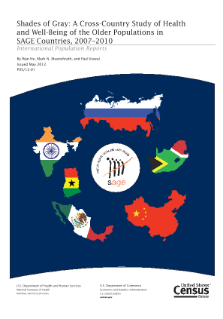Shades of Gray: A Cross-Country Study of Health and Well-Being of the Older Populations in SAGE Countries, 2007–2010
Shades of Gray: A Cross-Country Study of Health and Well-Being of the Older Populations in SAGE Countries, 2007–2010
Introduction
The world’s population is aging, primarily as a function of declining fertility, coupled with increasing life expectancy. Aging is occurring not only in high-income countries but in middle- and low-income countries as well. Moreover, the speed of aging in middle- and low-income countries will outpace that of the high-income countries (Kinsella and He, 2009). Although considerable attention has been paid to the aging of populations around the world, the vast majority of this attention and related research has focused on higher-income countries. Yet about 65 percent of the world’s population 60 years and older lived in less developed countries in 2010, and this proportion is projected to be 80 percent by the year 2050 (U.S. Census Bureau, 2012).
The health status of the aging population is essential not only to those who comprise this age group, but also to the broader population because of the impacts on social and economic systems. As the older population grows not only in size, but more importantly in their proportion of the total population, the potential implications for society will be increasingly salient. Understanding differences in the health of older populations across and within countries is critical for planning health care services and social support systems, and for designing population health policies. However, relatively few lower-income countries have the age-specific health and disability data necessary to determine basic population health parameters. Even less understood is which morbidity trajectory their respective aging population is following—expansion of morbidity, where people are living longer with more disease and disability (Gruenberg, 1977; Schneider and Brody, 1983); compression of morbidity, with delays in the age at onset and progression of disease (Fries, 1980, 2003); or a dynamic equilibrium where disability increases but is not as severe (Manton, 1982; Manton, Gu, and Lamb, 2006).
A major challenge in research on health differences across countries at older ages involves measurement of health outcomes (Banks and Smith, 2011; Crimmins, Garcia, and Kim, 2010; National Research Council, 2001). Self-reported health remains a cornerstone of health and epidemiological studies, but concerns about incomparability of self-reported health across studies and over time remains a problem for monitoring population health trends (Salomon, et al., 2009). In recent decades, a number of longitudinal or cross-national surveys, including the U.S. Health and Retirement Study (HRS), the Study on Health, Ageing, and Retirement in Europe (SHARE), and the World Health Survey (WHS), used the anchoring vignette methodologies to improve cross-country calibration of self-reported health. However, adjusting for these reporting biases across the various higher and lower income countries remains problematic. More recently, in response to this challenge, aging research studies have been adding objective health measures in an effort to improve estimates of the true levels of health.
As part of this greater effort, the World Health Organization’s (WHO) Study on global AGEing and adult health (SAGE) is working to improve measurement strategies across countries, while recognizing the need for further exploration to understand what underpins cross-country health differences (Kowal, et al., 2010). SAGE was conducted in six countries— China, Ghana, India, Mexico, Russia, and South Africa—across four different world regions (Figure 1). In addition to the consideration of geographic range and population size, these countries were representative of low- to upper-middle income countries and were at different stages of the demographic and epidemiological transitions (see Appendix C for more information on selection of SAGE countries).
This report uses SAGE Wave 1 data (2007–2010) and provides an overview of the “graying” populations in these six middle- and low-income countries. Analysis in this report focuses on comparisons across all six countries, or a subset of these countries, leaving in-depth, country-specific investigations to future reports. The report starts with Aging in SAGE Countries, which offers an overview of the aging process in these six countries, using the U.S. Census Bureau’s International Data Base (IDB), population projections data from the United Nations, and health data from the WHO. The report then presents findings from the SAGE data in the following sections: Demographic and Socioeconomic Characteristics, Health State and Chronic Conditions, Risk Factors and Preventive Health Behaviors, Disability, Life Satisfaction and Quality of Life, Depression, and Health Care Utilization. The health variables are cross-examined by age (50–69, 70 and older), sex, and urban/rural residence. The Summary and Discussion section provides conclusions from the SAGE data and also raises questions for future research. SAGE survey related information is included in the final section Sources of the Data and Accuracy of the Estimates.
The analysis in this report is based on self-reported responses. Estimates provided in this report are weighted. All comparative statements in the text have undergone statistical testing and are significant at the 90 percent confidence level unless noted otherwise. Note that not all comparisons shown in the figures and tables have undergone statistical testing and the differences between these estimates may not be statistically significant. Caution is needed when comparing data presented in the figures, text tables, and appendix tables.
Others in Series
Publication
Publication
Publication






